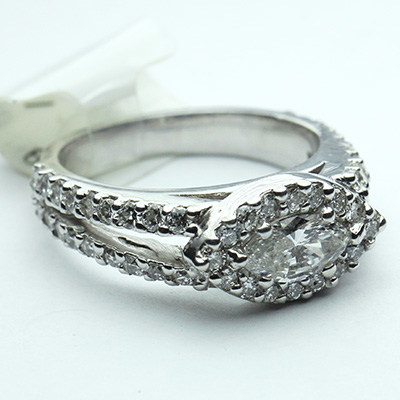Engagement Rings: Settings Guide
Engagement rings are meant to be timeless, treasured jewels to symbolize a couple’s love and commitment to one another. As such a meaningful piece of jewelry, it is no wonder that a lot of time and thought be put into choosing the ring. With so many options nowadays it may seem a bit overwhelming but let us give you a few pointers on the lingo used to describe the variety of engagement ring settings and the precious metals used to create them.
Engagement Rings: Settings



If you took a peek at our engagement ring history, you’ll know that diamonds set in gold weren’t always considered the classic engagement ring setting. However, for about the last 100 years that is the image most people think of when someone exclaims, I’m engaged! So here are some terms to help get you familiar with the many options you have when picking your engagement ring setting.
Prong or Shared Prong Setting: Prongs are the little metal ‘claws’ that hold a diamond or gemstone in place and are the most classic setting of engagement rings. Prongs are small enough that they allow the most light through the stone and you can choose to set with four prongs or six, with the latter being more secure. Shared prong settings are showcased with many diamonds lined up in the ring with each prong being shared between two stones. The look of this setting can be stunning but prongs should be checked from time to time to ensure they haven’t loosened. Also, the higher the prong setting the more likely they can snag so think about the activities your soon-to-be-betrothed does on a daily basis to decide if a lower, classic prong setting may be best.
Pavé or Micro-Pavé Setting: Diamonds or gemstones are delicately and precisely set within the metal in this sparkly setting. Using small chisels, the line of diamonds is directly set into its own tiny hole drilled into the ring setting. Then a burr is used to push some of the metal up over the stone, the result of which creates a small metal ‘bead’ between each diamond. This adds more sparkle to the ring and really makes the center stone pop! Depending on the size of the diamonds the setting can be considered pavé or micro- pavé. If the diamonds are between .01-.02 carats it is considered pavé and micro-pavé if they are smaller. Because of the delicacy of this process and the tiny diamonds, ring sizing can be a little tricky so be sure to know the correct ring size up front.
Channel Setting: Channel set wedding bands and engagement rings have diamonds set in between tiny grooves of two strands of precious metal. This is a very streamlined and secure setting with no worries of snagging.
Bezel Setting: Custom-made to hold the center stone and side diamonds or gemstones snuggly in place, the bezel setting is a very secure, snag-free choice. There are options for a full bezel where the stone is completely surrounded by the precious metal or a partial bezel which leaves the sides open to allow more light into the center stone.
Engagement Rings: Precious Metals
Yellow gold: Tradition has proven that gold is a sign of wealth, wisdom and the highest honor (eg. Gold Medal in the Olympics). Yellow gold is a metal that does not tarnish and is widely used in engagement rings and cultural nuptial jewelry to symbolize the everlasting, untarnished love of a couple. It is less expensive than platinum and is less dense so the weight of the ring will be lighter on the hand.
White gold: The look of white gold and platinum have spiked in popularity in recent decades. White gold is the same price range as yellow gold and is alloyed with other metals. This alloyed gold creates a whiter color, however, white gold still has a yellowish tint to it and so it is also plated with rhodium to create the ‘white, silvery’ look that helps compliment the brilliance of the diamonds. Depending on the wearer, white gold may need to be re-plated to keep its ‘white, silvery’ look but it is still in a more reasonable price than platinum.
Rose gold: Recent trends are showing rose gold settings in many engagement and wedding rings. This gold is made using the same amount of gold as yellow or white, as long as the carat is the same. For example, 14 kt yellow gold, 14 kt white gold and 14 kt rose gold all have the same amount of gold and differ only in the different metals they are alloyed with. In the case of rose gold, the rosy look is created from gold, copper and sometimes silver. Though these type of engagement rings may be more cost efficient than platinum they are not as widely available which can add to the romanticism and uniqueness of this setting.
Platinum: Platinum is a rarer, heavier precious metal and its cost reflects this. Because it is naturally white and doesn’t need plating or anything added to make it ‘whiter’ the color will not fade over time and it is a stronger metal than gold so it may stand up to more wear. Since it is the most expensive ring setting take into account what will suit the intended wearer best and decide how you want to use your budget since you may want to put more money into the stones.
We know there are many terms and countless options when it comes to engagement ring settings. As always, if you feel the endless possibilities are too much for you to decide on your own or you want to see the engagement ring settings in person, come visit your friendly Gilbert jeweler. We are always here to help you make a confident, forever decision on your engagement ring selection and purchase.
Explore the rest of our Engagement Ring series:
Engagement Rings: Settings Guide


